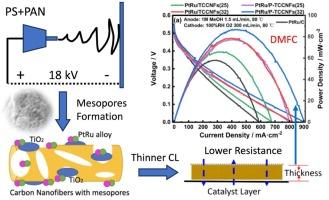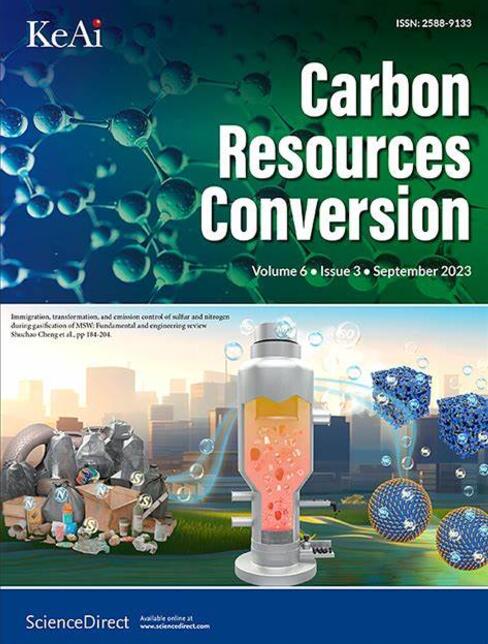高度发达的中孔碳纳米纤维催化剂载体提高了直接甲醇燃料电池的性能
IF 7.5
3区 环境科学与生态学
Q2 ENERGY & FUELS
引用次数: 0
摘要
以聚苯乙烯(PS)和聚丙烯腈(PAN)分别为成孔剂和碳基体,采用静电纺丝法制备了具有介孔的碳纳米纤维(P-CNFs),得到了更薄、反应活性更高的催化剂层,可用于直接甲醇燃料电池(DMFC)。PS与PAN的质量比为1.00时,介孔体积最大,平均孔径半径为4.7 nm。将PtRu和TiO2纳米颗粒包被在P-CNFs上,生成PtRu/ p - tccfs,并用于DMFC。PtRu/P-TCCNFs的电化学活性表面积(ECSA)大大超过了无孔碳纳米纤维(PtRu/TCCNFs),几乎是市售催化剂PtRu/C的两倍。ECSA值的提高主要是由于中孔区表面积的增加,有利于催化剂纳米颗粒的分散,从而防止团聚。因此,PtRu(32)/P-TCCNFs的甲醇氧化反应(MOR)质量活性达到438 mA/mg-PtRu,分别是PtRu(32)/TCCNFs和PtRu/C的1.27和4.56倍。此外,PtRu(32)/P-TCCNFs表现出优越的DMFC性能,这是由于催化剂层更薄,反应位点密度增加,欧姆电阻降低,从而产生更高的最大功率密度。本文章由计算机程序翻译,如有差异,请以英文原文为准。

Improved performance of a direct methanol fuel cell by the highly-developed mesopores of the carbon nanofibers catalyst support
A prepared carbon nanofibers with mesopores (P-CNFs) by electrospinning utilizing polystyrene (PS) and polyacrylonitrile (PAN) as the pore-forming agent and carbon matrix, respectively, to obtain a thinner catalyst layer which has an enhanced reaction activity for use in a direct methanol fuel cell (DMFC). A PS to PAN mass ratio of 1.00 yielded the highest mesopore volume with an average pore radius of 4.7 nm. PtRu and TiO2 nanoparticles were coated on the P-CNFs, producing PtRu/P-TCCNFs, and used in a DMFC. The electrochemically active surface area (ECSA) of the PtRu/P-TCCNFs significantly surpassed that of the nonporous carbon nanofibers (PtRu/TCCNFs) and was nearly twice that of the commercially available catalyst, PtRu/C. The improvement of the ECSA value is mainly due to the increased surface area in the mesopore region that facilitates the catalyst nanoparticle dispersion thus preventing agglomeration. Consequently, the methanol oxidation reaction (MOR) mass activity of PtRu(32)/P-TCCNFs reached 438 mA/mg-PtRu, exceeding that of PtRu(32)/TCCNFs and PtRu/C by 1.27 and 4.56 times, respectively. Furthermore, PtRu(32)/P-TCCNFs demonstrated a superior DMFC performance attributed to the thinner catalyst layer with the increased reaction site density and the reduced ohmic resistance, thus yielding a higher maximum power density.
求助全文
通过发布文献求助,成功后即可免费获取论文全文。
去求助
来源期刊

Carbon Resources Conversion
Materials Science-Materials Science (miscellaneous)
CiteScore
9.90
自引率
11.70%
发文量
36
审稿时长
10 weeks
期刊介绍:
Carbon Resources Conversion (CRC) publishes fundamental studies and industrial developments regarding relevant technologies aiming for the clean, efficient, value-added, and low-carbon utilization of carbon-containing resources as fuel for energy and as feedstock for materials or chemicals from, for example, fossil fuels, biomass, syngas, CO2, hydrocarbons, and organic wastes via physical, thermal, chemical, biological, and other technical methods. CRC also publishes scientific and engineering studies on resource characterization and pretreatment, carbon material innovation and production, clean technologies related to carbon resource conversion and utilization, and various process-supporting technologies, including on-line or off-line measurement and monitoring, modeling, simulations focused on safe and efficient process operation and control, and process and equipment optimization.
 求助内容:
求助内容: 应助结果提醒方式:
应助结果提醒方式:


